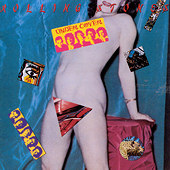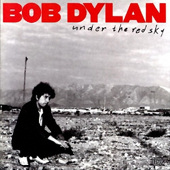15 Most Ill-Advised Career Reinventions in Rock Music History

The hardest thing about being a famous rock star is that people get sick of you. The only solution is to keep coming back as somebody else. After all, think of how quickly the world would have buried the Beastie Boys if they'd trotted out five albums that sounded like License to Ill.
The artists that do a good job of reinvention are allowed to hang around (like Radiohead and even Madonna, brief reign of terror as a rapper notwithstanding). But sometimes reinvention goes horribly, hilariously wrong, and none were worse than these:
Smashing Pumpkins Go Electronic
 When Smashing Pumpkins released Adore
When Smashing Pumpkins released AdoreWhile we won't know how the robots feel about the Pumpkins' work until long after Billy Corgan is dead, just about every human can agree it was awful. Drummer Jimmy Chamberlain was absent on this album, and the remaining members changed to a more gothic look, which presumably was meant to convey that the band was dead and needed to be put in the ground before it began to stink up the room.
KISS Make a Concept Album
 Aiming to recover from a string of failures, KISS decided to release a concept album. Rather than follow the path of successful concept albums by writing about clearly drawn characters that specific journeys, they instead went the Styx route and made a murky, ambiguous and ultimately unnecessary concept album. Music From "The Elder"
Aiming to recover from a string of failures, KISS decided to release a concept album. Rather than follow the path of successful concept albums by writing about clearly drawn characters that specific journeys, they instead went the Styx route and made a murky, ambiguous and ultimately unnecessary concept album. Music From "The Elder"Music From "The Elder", was so bad that the band didn't even go on tour to promote it. Let's take a second and consider that the boys who weren't above painting up their faces to look like stars and cats and wrote songs almost exclusively about partying, didn't want to go on tour with this album because it would have been too embarrassing.
Garth Brooks is Chris Gaines
 Speaking of soundtracks for movies that were never made, in 1999, harmless pop-country singer Garth Brooks decided to branch out musically and mentally. He became Chris Gaines, his darker, rock-singing alter ego and released an album of Gaines' songs that were supposed to function as a "pre-soundtrack" to precede The Lamb, the fictional Chris Gaines biopic Brooks was creating/starring in.
Speaking of soundtracks for movies that were never made, in 1999, harmless pop-country singer Garth Brooks decided to branch out musically and mentally. He became Chris Gaines, his darker, rock-singing alter ego and released an album of Gaines' songs that were supposed to function as a "pre-soundtrack" to precede The Lamb, the fictional Chris Gaines biopic Brooks was creating/starring in.
Sales of the album were much lower than anticipated, and because the project was equal parts of Brooks out of his league and just being totally stupid, the film was canceled and Chris Gaines politely faded away. This appeased those diehard Brooks fans who were worried if they supported the Gaines album, they would lose the doofy singer-songwriter they'd all come to love, for some reason.
Take note, country-haters: If you buy Chris Gaines' album, Garth Brooks will disappear. Just as a warning though: If you buy Chris Gaines' album, you will own a Chris Gaines album.
David Bowie Goes Industrial
 Normally a master of innovation and reinvention, Bowie went to the well one too many times in 1995 when he decided to be exactly like Trent Reznor, who was finally enjoying mainstream success with Nine Inch Nails' The Downward Spiral
Normally a master of innovation and reinvention, Bowie went to the well one too many times in 1995 when he decided to be exactly like Trent Reznor, who was finally enjoying mainstream success with Nine Inch Nails' The Downward SpiralHe got fucked like an animal in record--sales figures. Deciding that he wasn't nearly close enough with Reznor already, Bowie decided to co-headline the Outside tour with NIN. Reznor and company would occasionally play in the middle of Bowie's set to keep young fans from leaving. And, Bowie, presumably, would lock himself in a closet backstage during NIN's set for the exact same reason.
Van Halen Hires Gary Cherone, Eddie Decides to Sing a Track
 After a career of lead-singer drama, Van Halen decided to go in a completely different direction by hiring Gary Cherone. The former Extreme front man tried to distance himself from his "More Than Words" days by adding a little bit of grit to his voice, to much comic effect. Along with giving VH fans something they've never asked for in politically-minded songs like "Ballot or the Bullet," the songs here were stripped of any kind of edge and the whole thing fell just a few steps short of being new-age.
After a career of lead-singer drama, Van Halen decided to go in a completely different direction by hiring Gary Cherone. The former Extreme front man tried to distance himself from his "More Than Words" days by adding a little bit of grit to his voice, to much comic effect. Along with giving VH fans something they've never asked for in politically-minded songs like "Ballot or the Bullet," the songs here were stripped of any kind of edge and the whole thing fell just a few steps short of being new-age.
Somehow, inexplicably, Eddie Van Halen decided to take what was broke in the band and make it even more broken by singing lead vocals on one track, sending a message of, "Hey, it could be worse," to the many fans dissatisfied with Cherone's performance.
Bassist Michael Anthony appears in only three tracks on the album, marking what were either tensions within the band or forward-thinking wisdom on his part. Cherone was quickly dismissed from the VH lineup, and fans did their best to pretend he was never there in the first place.
 When the universe briefly righted itself and threw the gravy train of boy band pop off the rails, the New Kids attempted to stay popular and relevant by cleverly changing their name to NKOTB, firing original creator/producer Maurice Starr and focusing on harder material, including rap songs.
When the universe briefly righted itself and threw the gravy train of boy band pop off the rails, the New Kids attempted to stay popular and relevant by cleverly changing their name to NKOTB, firing original creator/producer Maurice Starr and focusing on harder material, including rap songs.
For some strange reason, nobody would buy the idea that this clean-cut group of guys who used to beg girls not to go in falsetto voices had any hard edges to them whatsoever. Their music significantly supported this idea.
The Members of Matchbox Twenty Quit Whatever Their Jobs Were Before to Pursue Music Full-Time

This is pretty self-explanatory, right?
Metallica Drops a Huge, Steaming Load
 Rarely has an album been more aptly-titled. With this load of crap, pioneering metal band Metallica decided they were done kickin' ass and pledged to never again record anything that wasn't of a length or quality acceptable to mainstream radio. The songs here were more sensitive and emotionally revealing, because let's face it, there comes a point in everyone's life where they need to stop the moshing, and start the hugging.
Rarely has an album been more aptly-titled. With this load of crap, pioneering metal band Metallica decided they were done kickin' ass and pledged to never again record anything that wasn't of a length or quality acceptable to mainstream radio. The songs here were more sensitive and emotionally revealing, because let's face it, there comes a point in everyone's life where they need to stop the moshing, and start the hugging.
Besides, what's more metal than hearing your song blasted from the convertibles of stockbrokers? More crappy albums followed, and then the final straw, Some Kind of Monster - a weepy documentary where they hug and cry and threaten to reunite with former band mate and fellow out-of-steam rocker Dave Mustaine. Now, die-hard Metallica fans are left like that guy in the video for "One," banging out "S.O.S." with their heads for eternity.
The Rolling Stones Put the "Cover" Back in "Cover Your Ears; This New Rolling Stones Album is Awful"
 The Rolling Stones had eight No. 1 albums in a row and were the undisputed champions of blues-hard rock fusion. In 1983, they decided that they wanted to do something special for their next album. Specifically, they wanted to record terrible music and make their fans hate them. A bold decision to be sure, but you don't become one of the biggest rock bands on the planet by recording consistently good albums, (apparently).
The Rolling Stones had eight No. 1 albums in a row and were the undisputed champions of blues-hard rock fusion. In 1983, they decided that they wanted to do something special for their next album. Specifically, they wanted to record terrible music and make their fans hate them. A bold decision to be sure, but you don't become one of the biggest rock bands on the planet by recording consistently good albums, (apparently).
The fault landed mostly on Jagger who, afraid to fall behind in this crazy new MTV generation, forced reggae and new wave influences in 1983's Undercover. Jagger also famously clashed with guitarist Richards who, finally emerging from a decades-long drug coma wanted to steer the band to its blues and rock roots. The compromise resulted in an unfocused and inconsistent album that alienated preexisting Stones' fans and repulsed the MTV crowd Jagger was so convinced he wanted.
U2 Takes a 12-Track-Long Shit
 The Edge, guitarist and No. 1 contender for the title of "Stupidest Alias in U2," described 1997's Pop
The Edge, guitarist and No. 1 contender for the title of "Stupidest Alias in U2," described 1997's PopU2, presumably armed with the idea that "We're U2, we can do whatever the hell we want," marched into the studio and proceeded to churn out 12 tracks of synthesized, sampled, techno dance beats with a few traces of guitar and his best delay pedal with some obligatory Bono wailing. When you're possibly the biggest band on the planet, we don't really understand the mentality in branching out to different genres. Who are you trying to reach, Bono? Is it space? Are you trying to conquer space, Bono? Do you think that space likes shitty dance music? That's pretty presumptuous, even for you, Bono.
Red Hot Chili Peppers
 The Red Hot Chili Peppers had turned some heads with the innovative funky, rap-rock blend of Blood Sugar Sex Magik
The Red Hot Chili Peppers had turned some heads with the innovative funky, rap-rock blend of Blood Sugar Sex MagikStep One: Get rid of song writing partner and guitar visionary John Frusciante.
Step Two: Replace him with metal-inspired possible trannie, Dave Navarro.
Step Three: Press record.
Singer and songwriter Anthony Kiedis was so depressed that he fell back into drugs after five years of sobriety. As a result, the album was less about sex and funk and more about drug-induced soul searching and heavy metal. Dave Navarro, the source of the metal, was reportedly concerned about the RHCP recording process. He often wondered why so much "jamming" was involved in the making of the album, which lead many music scholars to question whether or not Navarro had actually ever heard the Chili Peppers.
The album was commercially and critically unsuccessful and, with Frusciante's return to the band a few years later, it's easier for everyone to just pretend One Hot Minute never happened.
Lou Reed's Metal Machine Music Makes Millions Miserable
 Lou Reed has always been a little bit unpredictable and a little bit hard to label as an artist. You've got to admit, "Walk on the Wild Side" was pretty risky. Metal Machine Music, an album that entirely consists of guitar feedback played at different speeds, probably took that one step too far when the sounds on it technically no longer qualified as music.
Lou Reed has always been a little bit unpredictable and a little bit hard to label as an artist. You've got to admit, "Walk on the Wild Side" was pretty risky. Metal Machine Music, an album that entirely consists of guitar feedback played at different speeds, probably took that one step too far when the sounds on it technically no longer qualified as music.
Rolling Stone described the sounds of the album as "The tubular groaning of a galactic refrigerator" and "a night in a bus terminal," while popular comedy website Cracked.com drew similarities between listening to MMM and "etting ear-fucked by a toaster."
Pat Boone gets In A Metal Mood
 Hey you rebels and head bangers, are you still looking for a way to connect with your grandparents on a musical level? Well, here it is. Squeaky-clean gospel crooner Pat Boone puts a much-needed right-wing conservative spin on songs by Judas Priest, AC/DC and Metallica. Posing for the album cover in a leather vest and an earring, Boone takes the risk of alienating his traditional fan base for the reward of winning absolutely no new fans at all.
Hey you rebels and head bangers, are you still looking for a way to connect with your grandparents on a musical level? Well, here it is. Squeaky-clean gospel crooner Pat Boone puts a much-needed right-wing conservative spin on songs by Judas Priest, AC/DC and Metallica. Posing for the album cover in a leather vest and an earring, Boone takes the risk of alienating his traditional fan base for the reward of winning absolutely no new fans at all. Bob Dylan Wiggles into Obscurity
 Bob Dylan was the voice of a generation but, evidently, that can grow tiresome. With 1990's Under the Red Sky
Bob Dylan was the voice of a generation but, evidently, that can grow tiresome. With 1990's Under the Red SkyThe album was a busy and unfocused mess with too many guest stars that received negative responses both critically and commercially. To illustrate just how far removed this album was from Dylan's previous work, we've included some lyrics from the song "Wiggle, Wiggle" that, we feel, really represent the album as a whole:
"Wiggle, wiggle, wiggle like satin and silk,
Wiggle, wiggle, wiggle like a pail of milk,
Wiggle, wiggle, wiggle, rattle and shake,
Wiggle like a big fat snake."
Pretty deep, right? Because sometimes don't you just need to wiggle wiggle wiggle, like a big fuckin' pail of milk? No? You never find yourself in desperate need of some serious, milk-like wiggling? Hmm. Must be just Dylan, then.
MC Hammer Goes Gangsta, Except Not Really at All
 In 1994 MC Hammer dropped the "MC" and made a desperate run at street cred with the album The Funky Headhunter.
In 1994 MC Hammer dropped the "MC" and made a desperate run at street cred with the album The Funky Headhunter.
You'll recall he had the Hammer Pants sued off of him for sampling Rick James without permission, and this must explain why he is parading around in a male thong in the video for single "Pumps and A Bump."
Take notes, 50: nothing says gangster like a banana hammock.
The video opens with Hammer calling a friend and speaking either like someone raised on the streets or a rich pop-rapper who found a Street Dictionary, ("Yo, G, Peep this"). Regardless, neither pumping nor bumping rescued this train wreck of a video.
John Frusciante is a writer living in New York City. He hopes to reinvent himself as a phrenologist.